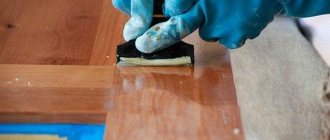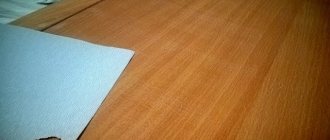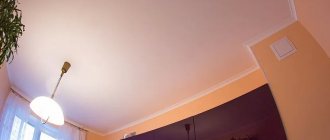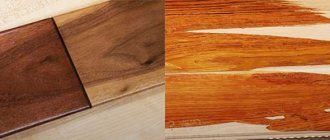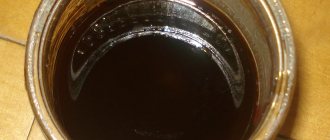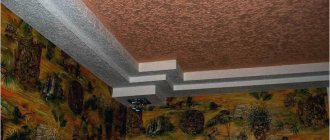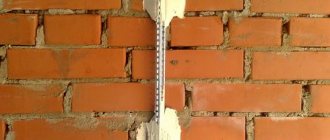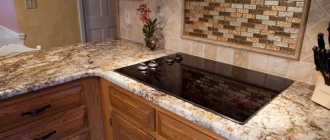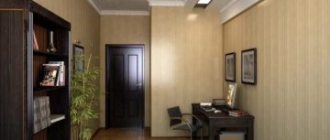A varnished table looks very attractive, and a layer of varnish makes the surface more functional and wear-resistant. Varnishing protects wood, prevents its destruction, and protects against the harmful effects of moisture and mechanical damage. Kitchen worktops especially need to be varnished, since wooden countertops are exposed to moisture and physical stress every day. This article will look at what varnish to coat a wooden table with, how to properly prepare the wood, and how to apply the varnish mixture.
Features of wood
Many furniture sets, including dining table tops, are made from wood. Wood can be either natural or made from wood chips, such as fiberboard, MDF, and others. Tables made of wood can be without finishing, and can also be covered with some kind of paint and varnish material.
Wood has many advantages, for example, high thermal insulation, beautiful appearance, various shapes, and wood is quite easy to restore. Despite these advantages, wooden tables and other products made from this material have several disadvantages - they get dirty quite quickly, are flammable, scratch quite easily, and are susceptible to mechanical damage. Another disadvantage of countertops made of natural wood is the high cost.
Which wood to choose for the countertop?
Here is the answer to the question of what types of wood and wood characteristics are worth paying attention to.
“When deciding on a wooden countertop in the kitchen, please forget about MDF, chipboard and veneer. Only natural wood,” advises Artyom Lepyoshkin, general director of the Dynasty House of Interior Solutions. It's not a matter of harmfulness, but of the properties of the material. The countertop is exposed to aggressive human influence every day: crumbling, cutting, whisking, spilling and spilling are a common occurrence in the kitchen. The surface must be durable, smooth, resistant to cuts, moisture and temperatures.
The classic option is oak or beech: strong and durable wood species. Some choose teak and mebrow. More affordable options: pine, walnut, ash, birch. We prefer larch: you will have to pay more, but it will also last longer. The peculiarity of larch is the very high density of wood; the growth rings are located along the trunk with small intervals. It easily tolerates mechanical damage and deformation, and can withstand high compression and pressure loads. It contains gum, a natural antiseptic that protects against rotting and damage by mold. Ideal for the kitchen. Larch gives off and absorbs moisture when humidity changes.
The manufacturing method also affects durability. A solid wood tabletop is more likely to warp than a laminated wood tabletop assembled from several plates. This method increases flexibility and elasticity.”
“You should pay attention to such points as: the age of the wood, the method of its extraction, storage conditions, the region where the material was brought from,” adds Mikhail Vychuzhanin. He considers oak to be the best type of wood for making countertops. — The stronger and harder the wood, the longer your countertop will serve you. There are countertops made from solid birch, cherry, and walnut.”
Ways to protect wooden surfaces
Every day, kitchen working surfaces are exposed to various liquids, mechanical stress, and are exposed to high air humidity. To extend the service life of furniture, it must be protected with a special compound. Today, in order to protect wooden products, the following methods are used:
- The surface is treated with a special oil, it penetrates deeply into the wood and subsequently prevents swelling when the wood comes into contact with moisture or liquids. High-quality and effective oils for treating wooden tables are the following compositions: Belinda, OSMO TopOil, Adler Lengo, etc. For maximum protection, it is advisable to apply wax mixtures to cover the wooden tabletop. However, wax and oil provide short-lived protection and require renewal from time to time.
- The working surface is treated with a special varnish. You can add tinting pigments to the varnish for a wooden table, allowing you to change the shade of the wood fibers and also make the surface more saturated. Covering a table with a varnish is much easier than treating it with wax or oil.
Oil: advantages and disadvantages
Adherents of eco-design and the most natural interiors often opt for oil. This has several aesthetic advantages:
- the warmth of the wood is preserved;
- as well as pleasant tactile sensations from touching it;
- The surface texture is further emphasized.
This coating option also has practical advantages:
- minor abrasions and scratches are less noticeable on oil-impregnated wood (compared to a varnished surface);
- in case of serious contamination and damage, you can carefully remove the coating area and reapply oil to it;
- vegetable oils are an environmentally friendly, safe coating for countertops; you can safely place food on the coated surface;
- It is quite possible to update the oil coating yourself (working with varnish will require much more serious skills).
The key disadvantage of coating wood with oil is the lack of reliable protection against prolonged contact with water.
Of course, if you accidentally spill something and wipe it up immediately, nothing bad will happen. However, if you leave the liquid on the countertop for a longer period of time, the area may darken.
Also, oil does not protect very reliably from mechanical influences, but in combination with wax it is not so much inferior to varnish.
Types of varnishes
To make a wooden product attractive again, you need to choose the right type of varnish mixture. Today there are a huge number of different options in stores, and it is difficult for the average consumer to make a choice. It is necessary to select a type of varnish that will maximally protect the surface from harmful influences and improve aesthetic properties. If the varnish composition does not protect the base well, then damage will begin to appear on it, which will remind you of itself every day and spoil the appearance of the wooden surface, so it is important to take the choice of varnish solution seriously.
Alcohol varnishes
This type of varnish creates either a transparent or translucent protective layer with a glossy sheen. If you cover the wood with an alcohol varnish mixture, it will be reliably protected from moisture and mechanical damage. If you follow the instructions for applying the composition, the alcohol-based paint and varnish material will effectively emphasize the attractiveness of natural wood.
These varnish solutions consist of resins dissolved in alcohol; after drying, they form a highly durable film. It is advisable to purchase a composition with strong alcohol, which will ensure high strength of the protective layer. The best option is an alcohol content of over 90 percent alcohol.
Oil varnish solutions
They are pigments and resins that are dissolved in oils. This variety has a thick consistency, its advantage is its affordable, low price. After drying, this solution creates a film that is quite durable and resistant to negative influences.
Oil compositions are ideal for coating wooden products, especially those that are outdoors all year round, in the open air. If you cover a table with an oil-based varnish, it will acquire a permanent yellowish tint, which will not go away after a while.
Nitrovarnishes
These solutions are made from nitrocellulose with the addition of organic solvents. These compounds have excellent performance properties, but they are very toxic to humans and have a detrimental effect on health. If you cover a tree with them, it will be reliably protected, but even after the varnish mixture has dried, a slight unpleasant odor will remain. Today, fewer and fewer nitro varnishes are being produced, which are gradually being replaced by alcohol varnish solutions that can be applied to pine, oak, and other types of wood.
Water-based varnishes
This variety can be used in residential premises; aqueous compositions are absolutely safe for human and animal health and are environmentally friendly. They consist of acrylates dissolved in ordinary water. If you cover furniture with them, after drying, a durable protective layer is formed that is resistant to physical stress, humidity and ultraviolet rays.
They are suitable for processing pine and can be used to cover hard or soft wood. In terms of strength, water-based compositions are inferior to other varnish varieties. For example, IKEA varnish is often used to cover various sets, including children's furniture, but from time to time the varnished water layer needs to be renewed.
Polyurethane compounds
Polyurethane-based varnish mixtures have good elasticity after drying and are resistant to serious mechanical loads and impacts. Polyurethane compounds dry quickly, but have little resistance to moisture and water. Polyurethane-based mixtures are safe for humans, they do not turn yellow over time, are very attractive, and remain transparent for a long time. Before covering the base with a polyurethane solution, there is no need to prime the product.
Coating process
Proper treatment of a wooden surface is the key to its long service life. This rule especially applies to kitchen countertops. In addition to the fact that you need to choose the right treatment product, it is also important to properly prepare the surface, apply protection and dry. The following describes the process of how to coat surfaces using oil compositions as an example.
The coating process follows certain rules.
Preparing the wooden surface
The first step will be to clean the countertop from all kinds of dirt and greasy marks. Next it is dried.
Before coating, the surface must be cleaned of dirt.
On a note! The wood moisture content should be no more than 12% according to DIN EN 13183-2.
To ensure that the oil adheres well and is absorbed, the wood is sanded, starting with coarser abrasives, gradually moving to finer ones. Also, after each abrasive, the coating is cleaned. You may need to putty it to remove deeper scratches. A special restoration kit based on wax is ideal.
The wood should be sanded so that the coating lays more evenly.
Preparation of the product
The main thing you need to pay attention to when choosing a coating is its quality. A good protective agent will protect the wooden surface from mechanical damage and moisture and give it a shiny, renewed look.
The coating must be of high quality to provide the furniture with protection and a well-groomed appearance.
The product must also be prepared. Before treating a wooden countertop in the kitchen, the composition must be thoroughly mixed for 5 minutes.
The product must be mixed well.
Application
The composition is applied with a brush or cloth, and the latter should not leave lint on the surface. It will take about 12 hours for the first layer to dry. Then you can apply the next one, and so on. The number of layers will directly depend on how the product is applied. Using a brush, two treatments are enough; a fabric coating will require up to 4 layers.
Use a brush or cloth for application.
When the product is well absorbed, the entire treated area is thoroughly wiped with a soft and clean cloth.
After the product has been absorbed, wipe the surface with a cloth.
Drying
Drying time varies from several hours to several days. Naturally based oils or mixtures containing acrylic require a longer drying period. They can also increase strength gradually. It is important not to use a freshly treated countertop for a while.
After applying the coating, it is important to let the furniture dry.
Preparation before varnishing
Before varnishing a wooden table, it must be properly prepared. The first step is to completely remove the old coating, it can be varnish or paint. You can clean the base using sandpaper or a power tool. When all the old coating has been removed and the base becomes smooth, without any defects, you can move on to the next stage. If there are, for example, chips or cracks, they must be puttied with a special mixture.
You can remove old paint and varnish material using a chemical remover. It is applied to the wood, and after the time interval specified in the instructions, it is removed using a rag or spatula. In addition to chemical compounds, heat treatment using a hair dryer is also used. With this tool you need to heat the countertop, and then remove the old material using a spatula. The mechanical method using sandpaper or an electric sander is also suitable, but you need to work with them carefully so as not to damage the wood.
Varnish: advantages and disadvantages
An alternative coating for wood is varnish. It also has its own aesthetic advantages:
- the ability to create a glossy, semi-gloss or matte surface of your choice;
- get a perfectly smooth coating to the touch.
Varnish has many practical advantages:
- more reliable (compared to oil) protection of wood from moisture;
- greater protection of wood from mechanical damage;
- the ability to choose a tinted coating or add a special pigment that makes the wood pattern more expressive.
However, there are also disadvantages. The main thing is that all small scratches and chips will be quite noticeable on the varnished surface. But it won’t be possible to update just a section of the countertop: you’ll have to re-cover the entire area.
It is also not recommended to varnish surfaces that come into direct contact with food. However, modern manufacturers offer many options for environmentally friendly varnishes to circumvent this drawback.
Varnishing rules
Many people are interested in how to properly varnish a tabletop? To do this, it is advisable to use a roller or brush. If a colorless varnish composition is applied in one layer, then it is quite difficult to achieve the desired shade of the coating, so it is better to varnish in several layers.
To obtain a rich shade, you can pre-treat the surface with a colored primer or stain; they can be applied in several layers. After they dry, you can start varnishing. What kind of varnish can be used to coat a pine tabletop? Polyurethane and water-based varnish compositions are suitable, although other varieties can be used, but before doing so, you need to read the instructions to make sure that a particular varnish is compatible with the type of wood.
The varnish solution must be applied in a thin, even layer; drips must not be left. When the first layer has dried, it is advisable to sand it with sandpaper. The dust is then removed and another coat or two of the varnish mixture is applied. About one or two days after applying the final coat, the varnish coating will dry, and the old table will turn into a very attractive, new piece of furniture.
How to preserve the table for a long time? All about varnishes and coatings
When we buy something worthy for our home that we love at first sight, most of all we want to make sure that the product stays with us for as long as possible. Therefore, we begin to think about which bedspread will protect the sofa more reliably, which upholstery will be stronger for the chair, and also which varnish will best cover the table and other surfaces, preventing possible changes.
So that you don’t get confused and quickly understand this issue, we have prepared a short review that will tell you what a varnish coating actually is, what they are like today, and also how to cover your favorite table yourself at home.
Rice. 1 Lacquered tables
First: about varnishes and their types
It is important to understand what a varnish coating is, how safe it is, and whether it is required in your case.
Varnish is a solution of polymers, artificially synthesized or natural (for example, resin), and a solvent (or water). When hardened, it forms a glossy or matte durable film that protects various surfaces from external influences.
Today there are many variations of varnish coatings; it is extremely easy to get confused, but it is also easy to understand if you know the main differences and types. Let's look at the main ones.
We recommend: Alkyd varnish - types, properties and application features
1. Nitrocellulose. Pros: dries quickly, does not form a thick film. Cons: not so tolerant of external influences (low strength). This type is good for, say, chairs in the house.
2. Acrylic. Pros: very durable coating, protects against fading. Cons: If applied incorrectly, it may bubble. Suitable for almost all surfaces in the house, however, use it very carefully on the floor. It is advisable to entrust the application of this type of varnish to large surfaces to specialists.
3. Polyurethane. One of the most popular today. Its advantages: dries very quickly, unpretentious, moderately strong, durable. Cons: It turns a little yellow if it covers a light surface. But, given all the advantages, you can ignore such a small nuance. Still, this type of varnish is most suitable for all surfaces, without restrictions and does not have any significant functional drawbacks.
4. Water based. Pros: More environmentally friendly than other options. Cons: takes a long time to dry, does not have a very high degree of durability. Also suitable for covering any surface - from the floor to the table.
Rice. 2 Varnishing process
5. Polyester. These varnishes are very durable, thick, and create a thick protective layer. However, they are more harmful to others and have a pungent odor. Good for covering cabinet furniture if you want a glossy surface. But they are not very suitable for covering the surface of a table or chairs.
6. Oily. Advantages of varnish: durability, resistance to abrasion and temperature changes, practically odorless. But there are also disadvantages: it is difficult to compatible with other products, so it is extremely important to know in advance what kind of varnish the surface was coated with before.
What varnish coating is better to choose for the table?
If you think about it, we require that the table surface:
a) maintained a presentable appearance for a long time, that is, was persistent; b) withstand different temperature conditions (hot and cold dishes); c) it wasn’t too dirty (since the kitchen is the area where we most often get surfaces dirty); d) had no harmful properties; e) had a thin layer of varnish (tables that are shiny from the shine of the varnish surface do not look very aesthetically pleasing).
The best options under such conditions are polyurethane and acrylic varnishes. They fit every point and are easier to apply yourself. How? Read about it below.
Second: how to apply varnish on a table at home
To cover the surface of the table evenly and without flaws, you need to follow clear and logical rules. And try not to miss or confuse them.
So, first, prepare the surface. First we plaster, leveling everything inside and out, then we putty on the dimples and cracks - and, finally, we cut off the tubercles. We go over each cut again with a sanding sponge. Your fingers should literally glide across the surface - then you can be sure that everything is ready.
Before applying varnish, wipe the table from dust and debris.
Next, you will need gloves to protect your hands, as well as a main and spare hand. Since during the application process the varnish may dry out on the brush too quickly - and you will not be able to continue working quickly. The spare, in such a situation, will come to the rescue.
Rice. 3 Varnishing the table, applying the first layer
Remember: the first layer is the most important. It should be more liquid than the rest. Less thick to dry faster. After applying it, it is important to thoroughly plaster the surface before applying the second layer. Most often, three layers are applied to the table, plus a finishing sealer.
Third: a few words in conclusion
It may seem to you that the process of choosing varnish coatings for a table is complex, routine and exhausting. And covering it is even more difficult. In fact, if you understand exactly where and how the table will be used in the future. And also what influences it will be exposed to. Then you can choose the option that fits in organically and will serve you for decades.
Why update your favorite furniture every year if you can try a little and extend its service life for a long time to come? The choice, as always, is yours.
Purpose
Furniture varnish is a film-forming composition intended for the treatment of wooden bases. It is designed to perform the following tasks:
- protect surfaces from mechanical influences;
- make wooden products glossy (shiny) or matte;
- emphasize the natural beauty of wood (especially valuable species);
- create an impenetrable barrier to moisture, which can cause the wood to dry out or swell;
- protect from biological influences (fungus or harmful insects);
- increase the service life of expensive wooden furniture.
Varnishes for wooden furniture can be slightly tinted by adding pigment, or a transparent version can be used. They must be applied in several layers to ensure reliable protection.
How to protect a wooden table
There are three main options:
| Illustration | Description |
| Special oil . The wood is impregnated with it over the entire surface. The composition penetrates deeply into the structure of the material, providing protective properties. Next, the surface needs to be polished with wax to make it smooth and fill all the pores. The end result looks good, but the polishing requires periodic updating, which is not very convenient. | |
| Painting the table . A popular solution that is simple: the surface is sanded and, if necessary, puttied. Some people pre-apply primer to the wood for the best effect and to strengthen the material. The disadvantage of this solution is that the paint hides the texture of the wood and the result is ordinary, plain furniture. | |
| Applying varnish . If you do not want to hide the beauty of the wood, then the table needs to be varnished. This process is not complicated; the surface is sanded and leveled, after which varnish is applied. To make the layer stronger and more wear-resistant, it is recommended to treat the surface in 2-3 layers. |
Principles of assembling a plywood table
The functionality and durability of the finished product is determined not only by the quality of the material, but also by the correct execution of the carpentry work. If the structure is assembled from plywood scraps, then installation can begin only after the glued sheet has completely dried. In this case, excess glue must be immediately removed from the surface so as not to spoil the appearance of the finished product.
It is very important to correctly execute the template, which is then transferred to the plywood sheet. If the design has a complex shape, then you need to correlate the capabilities of the jigsaw with the dimensions of the elements being cut. The tabletop must be perfectly symmetrical; allowances must be left for subsequent sanding and removal of sharp corners. During the grinding process, the surface must be made perfectly smooth - without tears, burrs and other defects.
It is important not only to process the material efficiently, but also to securely fix the structural elements. To do this, it is recommended to use wood screws and metal corners (if necessary). To prevent cracking of the material during the process of screwing in the screws, it is recommended to pre-drill holes that will be slightly (about 2 mm) smaller than the diameter of the screws. This will not only reduce the risk of damage to parts, but will also simplify the workflow.
To increase the reliability of fixing parts of the product, you can additionally use wood glue. In this case, the work is carried out as follows: the parts to be joined are sanded to perfect smoothness, cleaned of dust, lubricated with glue, pressed tightly against each other, fixed with clamps and left in this position until completely dry, and then fastened with self-tapping screws.
Before assembling the table, it is necessary to make drawings of the future product. You can also select ready-made diagrams and adjust them to the required dimensions. Making furniture without drawings is fraught with mistakes, which are then extremely difficult, and sometimes even impossible, to correct.
Types of wood varnishes
1. The most popular and frequently used varnishes for application on wood are alcohol varnishes, the base of which consists of rosin and shellac. These varnishes dry quickly, saturate the wood well, as a rule, they are applied in 3-4 layers. In addition to these advantages, they also have some disadvantages, such as a rather complex application technology and low wear resistance. Very often they are used for furniture restoration, but at home it is quite difficult to achieve excellent results.
2. Oil varnishes are also used to coat wood. They dry much slower than the first option, but they give the product a special shine, have high strength and a wide selection of color shades. Such varnishes are well suited for furniture, woodwork, etc. And if you put in some effort and follow certain rules, you can varnish the furniture yourself. These varnishes thicken quickly and require dilution in the future.
3. Well suited for application on wood and water-based acrylic varnishes, they are mainly used for interior work. They have fairly high strength indicators and help the wood maintain its natural texture.
4. Epoxy varnishes for wood have also proven themselves to be excellent. They are highly waterproof, resistant to various influences, and dry quickly. The range of application of these varnishes is wide; they are used for both internal and external work.
In addition to the above, there are some other types that are suitable for working with wood. You also need to remember that when choosing a varnish for wood, you should take into account some points.
- Type of wood.
- Operating load of the product.
- Lighting.
- Humidity and temperature in the room where the wood will be processed.
How to restore the surface
If you decide to impregnate a wooden surface in the kitchen with oil and hard wax, the product can be easily restored in case of scuffs and scratches. For prevention, it is recommended to coat the surface with oil impregnation on average once a year. How often the countertop will need to be re-treated depends on the intensity of its use and climatic conditions.
To restore protective and aesthetic functions, it is advisable to use oil with good quality hard wax. The processing technology is as follows:
- The oil should be thoroughly stirred so that the wax contained in it is evenly distributed throughout the volume.
- Use a thin layer of oil mixture using a lint-free cloth or brush to cover the entire surface to be treated.
- After 15 minutes, thoroughly wipe off the excess coating with a cloth and leave without use for 12 hours to dry.
If you decide to restore the varnish surface, you will not be able to do it yourself. If there are scratches or abrasions, it is necessary to sand off and re-varnish the entire surface of the product. To do this, you will need the help of professionals who have the necessary equipment.
How and with what to paint a wooden table with your own hands - analysis of the best options
Restoring old favorite interior items has become a fashionable trend among modern designers. Few people know how to paint a table themselves, preferring to purchase a new analogue. However, you shouldn’t rush to throw away good quality furniture that has lost its former appearance when you have the opportunity to show your creative imagination and create a unique hand-made masterpiece. Experienced specialists will tell you how to varnish a table with your own hands and what paint is best to choose.

